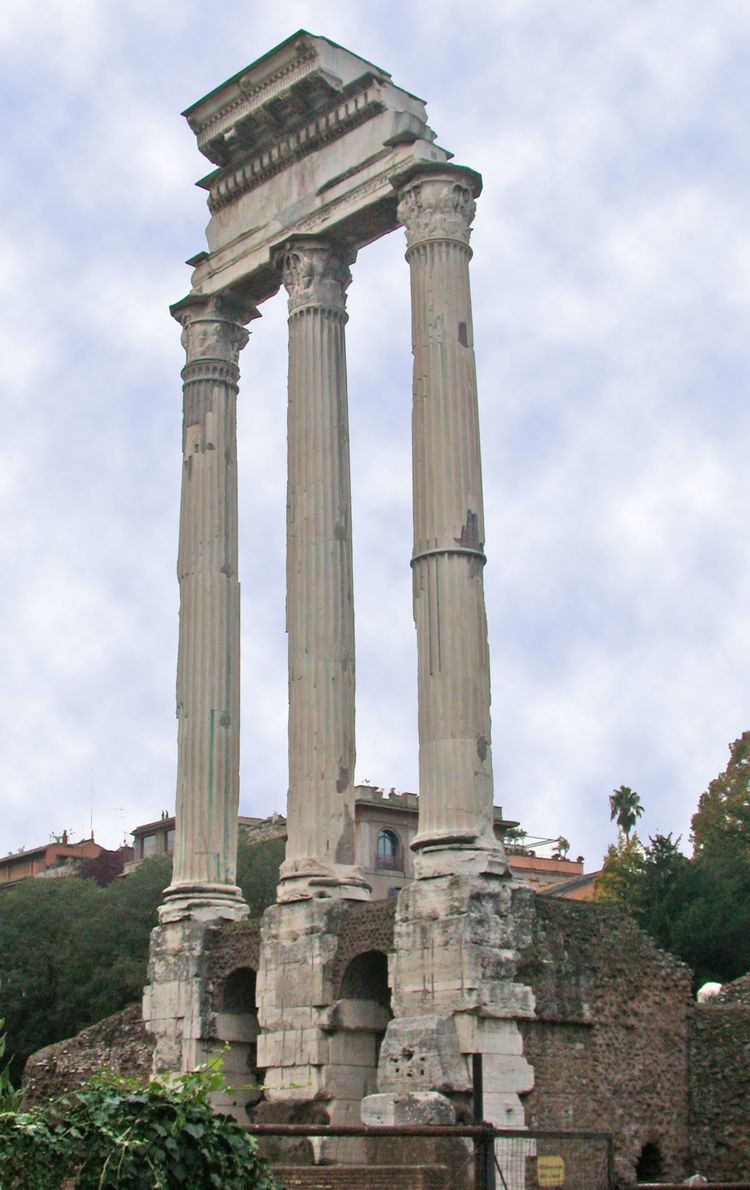Built in 495 BC Name Temple Castor | Type of structure Roman Temple | |
 | ||
Location Regione VIII Forum Romanum Related Hours Open today · 8:30AM–7:15PMMonday8:30AM–7:15PMTuesday8:30AM–7:15PMWednesday8:30AM–7:15PMThursday8:30AM–7:15PMFriday8:30AM–7:15PMSaturday8:30AM–7:15PMSunday8:30AM–7:15PM Similar Temple of Saturn, Basilica Julia, Temple of Vesta, Temple of Antoninus and Faust, Basilica Aemilia | ||
Roman Forum Part 3: Temple of Castor and Pollux
The Temple of Castor and Pollux (Italian: Tempio dei Dioscuri) is an ancient temple in the Roman Forum, Rome, central Italy. It was originally built in gratitude for victory at the Battle of Lake Regillus (495 BC). Castor and Pollux (Greek Polydeuces) were the Dioscuri, the "twins" of Gemini, the twin sons of Zeus (Jupiter) and Leda. Their cult came to Rome from Greece via Magna Graecia and the Greek culture of Southern Italy.
Contents
- Roman Forum Part 3 Temple of Castor and Pollux
- Giovanni matranga explains the temple of castor and pollux in agrigento
- Founding
- History
- Architecture
- Archaeology
- References

Giovanni matranga explains the temple of castor and pollux in agrigento
Founding

The last king of Rome, Lucius Tarquinius Superbus, and his allies, the Latins, waged war on the infant Roman Republic. Before the battle, the Roman dictator Aulus Postumius Albus Regillensis vowed to build a temple to the Dioscuri if the Republic were victorious.
According to legend Castor and Pollux appeared on the battlefield as two able horsemen in aid of the Republic; and after the battle had been won they again appeared on the Forum in Rome watering their horses at the Spring of Juturna thereby announcing the victory. The temple stands on the supposed spot of their appearance.
One of Postumius’ sons was elected duumvir in order to dedicate the temple on 15 July (the ides of July) 484 BC.
History
In Republican times the temple served as a meeting place for the Roman Senate, and from the middle of the 2nd century BC the front of the podium served as a speaker's platform. During the imperial period the temple housed the office for weights and measures, and was a depository for the State treasury.
The archaic temple was completely reconstructed and enlarged in 117 BC by Lucius Caecilius Metellus Dalmaticus after his victory over the Dalmatians. Gaius Verres again restored this second temple in 73 BC.
In 14 BC a fire that ravaged major parts of the forum destroyed the temple, and Tiberius, the son of Livia by a previous marriage and adopted son of Augustus and the eventual heir to the throne, rebuilt it. Tiberius' temple was dedicated in 6 AD. The remains visible today are from the temple of Tiberius, except the podium, which is from the time of Metellus.
According to Edward Gibbon, the temple of Castor served as a secret meeting place for the Roman Senate. Frequent meetings of the Senate are also reported by Cicero. He said the senate was roused to rebellion against Emperor Maximinus Thrax and in favor of future emperor Gordian I at the Temple of Castor in 237 AD.
The temple was probably already falling apart in the fourth century, when a wall in front of the Lacus Juturnae was erected from reused material. Nothing is known of its subsequent history, except that in the 15th century, only three columns of its original structure were still standing. The street running by the building was called via Trium Columnarum.
In 1760, the Conservatori, finding the columns in a state of imminent collapse, erected scaffolding for effecting repairs. Both Piranesi and the young English architect George Dance the Younger were able to climb up and make accurate measurements; Dance had "a Model cast from the finest Example of the Corinthian order perhaps in the whole World", as he reported to his father.
Today the podium survives without the facing, as do the three columns and a piece of the entablature, one of the most famous features in the Forum.
Architecture
The octastyle temple was peripteral, with eight Corinthian columns at the short sides and eleven on the long sides. There was a single cella paved with mosaics. The podium measures 32 m × 49.5 m (105 ft × 162 ft) and 7 m (23 ft) in height. The building was constructed in opus caementicium and originally covered with slabs of tuff which were later removed. According to ancient sources, the temple had a single central stairway to access the podium, but excavations have identified two side stairs.
Archaeology
The temple complex was excavated and studied between 1983 and 1989 by a joint archaeological mission of the Nordic academies in Rome, led by Inge Nielsen and B. Poulsen.
